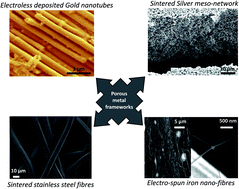The fabrication and surface functionalization of porous metal frameworks – a review
Abstract
Porous metal frameworks offer potentially useful applications for the aerospace, automotive and bio-medical industries. They can be used as electrodes, actuators, or as selective membrane films. The versatility of the physical features (pore size, pore depth, overall porosity and pore surface coverage) as well as the large range of surface chemistries for both metal oxides and pure noble metals offers scope to functionalise metal nano-particles and networks of nano-porous metal structures. As well as traditional routes to producing metal structures, such as metal sintering or foaming, novel high-throughput techniques have recently been investigated. Nanoparticle self-assembly, metal ion reduction and deposition as well as metal alloy de-alloying were identified as sustainable routes to produce large surface areas of such nano-porous metal frameworks. The main limitations of the current fabrication techniques include the difficulty to process stable and homogeneous arrays of nano-scale pores and the control of their morphology due to the high reactivity of nano-structured metal structures. This paper aims at critically reviewing the various fabrication techniques and surface functionalization routes used to produce advanced functional porous metal frameworks. The limitations and advantages of the different fabrication techniques will be discussed in light of the final material properties and targeted applications.

- This article is part of the themed collection: 2013 Journal of Materials Chemistry A Hot Papers

 Please wait while we load your content...
Please wait while we load your content...